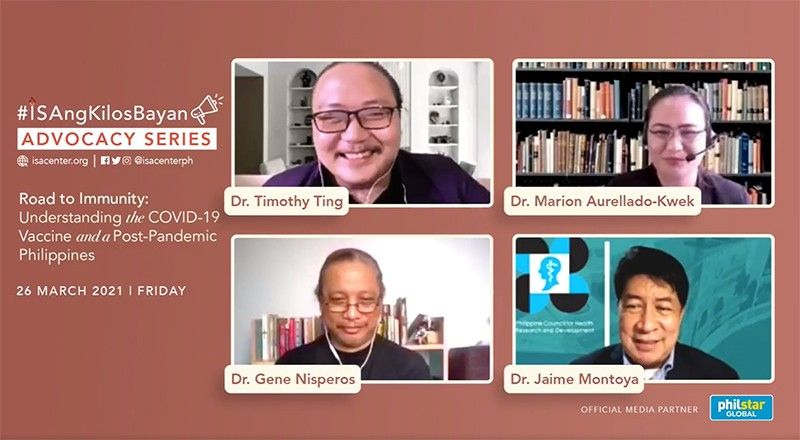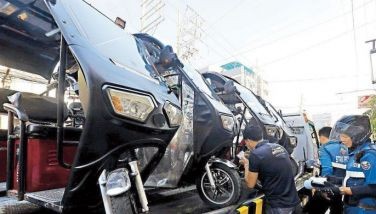#ISAngKilosBayan: Addressing the vaccine confidence gap

MANILA, Philippines — More than a year into the COVID-19 pandemic, the Philippine government began to roll out its immunization campaign to combat the coronavirus. But since then, the vaccines raised more questions than answers, leaving the nation caught between fear and hope.
To address these pressing questions and set the record straight about vaccines, the Institute for Solidarity in Asia (ISA) held its first #ISAngKilos Bayan Advocacy Series for the year entitled, “Road to Immunity: Understanding the COVID-19 Vaccine and a Post-Pandemic Philippines”.
In partnership with Philstar.com, the webinar convened public health experts, namely Dr. Jaime Montoya of the Philippine Council for Health Research and Development, Dr. Marion Aurellado-Kwek of the Philippine Society for Microbiology and Infectious Diseases and Dr. Gene Nisperos of the University of the Philippines Manila – College of Medicine.
Moderated by Dr. Timothy Ting of the Asian Institute of Management, the panelists shed light on the role, efficacy and safety of vaccines through the lens of public health and shared their visions of a post-pandemic Philippines.
Not a solution but an added protection
The arrival of COVID-19 vaccines in the country offered the public a shot of hope in the ongoing battle against the pandemic. But while vaccines are highly effective in preventing the spread of the virus, Nisperos emphasized that these are not the only solution to ending COVID-19.
“Ang natutulong ng bakuna is nadadagdagan ‘yung kumpyansa natin na maprotektahan ang mga vulnerable. Pero hindi lang natin kinakahon [sa bakuna] ‘yung response. Hindi ito solusyon. Isa siyang dagdag na proteksyon,” he said.
Similarly, Aurellado-Kwek shared that the vaccine serves as an extra armor for health workers on the frontlines.
“It’s an added protection to us. Even though we are trained, we do worry. Malaki ang tulong for our morale to know we have extra protection apart from the PPE (personal protective equipment), engineering, and et cetera,” she said.
Vaccines also provide indirect protection called “herd immunity”, a concept showing fewer chances of spreading the virus if one is immune, protecting not only oneself but also the community. But with the substantial portion of the population needed to be vaccinated to achieve herd immunity, Aurellado-Kwek said that much work remains to be done.
“From the latest na 2020 estimate ng population, which is 120 million, dapat around 70% of that are protected or received the vaccine for us to possibly achieve that herd immunity. We are a long way to go,” she said.
Rapid but safe vaccine development
Due to the high demand for vaccines worldwide, scientists and pharmaceutical companies persevered to develop a COVID-19 vaccine as quickly as possible. But the rapid development of vaccines raised more public concern that quality and safety were sacrificed in favor of speed. However, Montoya assured that the standard of vaccines was not compromised in the process, thanks to technology and learnings from past epidemics.
“Comparing 2020 to 2010, the environment is very different. The level of tech, advancements in science is unparalleled. And this is not the first time na we faced an epidemic because we’ve had SARS COVID-1 in 2003, MERSCOV in 2015, et cetera. They’ve been doing the work for five to ten years, coming from their experience from the past epidemics,” he said.
Montoya also stressed the important role of the emergency use authorization (EUA) implemented by the Food and Drug Administration in the country’s response to emergencies using treatments such as the vaccine.
“[EUA] is a mandate implemented by the FDA. [Vaccines] cannot be commercially available unless it’s part of the government program. We have never heard of the EUA prior to the pandemic because the Philippine FDA did not have the power to do EUA. Now we realize, important pala 'yun. Otherwise, we have to wait for the full Phase 3 [of clinical trial] that is around three to five years,” Montoya said.
Too much information and misinformation
Apart from the virus, the country also faces a huge challenge in controlling the spread of misinformation about the vaccine among the public. Nisperos said with too many details and updates about the vaccine and the virus, people are left more confused and misinformed.
“Ang daming naco-confuse sa taong bayan kasi maraming jargon. Minsan pag may magaling na mage-explain, pero mali 'yung explanation niya, ‘yun pa yung left in the impression of the people. The overwhelming jargon ay hindi nila ma-piece together. Even intelligent people, hirap sila i-piece together kasi there are too much misinformation and information,” he said.
Aurellado-Kwek also shared her concern about how many people downplay the fatality rate of the coronavirus and the role vaccines play in this health crisis.
“A lot of the updates in the statistics say na two percent lang naman ang namamatay so iyung iba they feel na ‘di nila kailangan ng bakuna. Pero [kung] 120 million ang population ng bansa, marami po ‘yung two percent na ‘yun. It’s not as simple as looking at the case fatality to measure the cost of the pandemic. It’s important to emphasize na kahit ganito lang kababa ay marami paring maapektuhan kaya we really need these vaccines and this can help us reach our goal in protecting the country,” she said.
Efficacy has also been a hot topic since the first available vaccines were reported and introduced to the public. But Montoya reminded that regardless of its efficacy rate, a vaccine is safe to use as long as it was approved by the FDA and met the minimum requirements.
“People don't realize that some of the vaccines that we use now are not even in the range of 90% or more. Ang efficacy rate is naglalaro lang ng 50 to 60% but we are using it. We would have been happy with a 50% efficacy if not for the 90% efficacy rate reported by the first vaccines,” Montoya said.
Whole-of-nation approach
On March 1, 2021, the Philippines officially kicked off its vaccination program. But the pandemic is far from over. Many vaccines have yet to be acquired and millions of vulnerable Filipinos remain to be unprotected from the virus. But Nisperos highlighted that apart from the efforts of the government, the solution calls for intense and active participation from the public.
“The government can’t handle this crisis on its own. We need the help of the people,” he said. “In the last year, we saw the attitude towards Filipinos is ‘sumunod na lang kayo’ rather than making them part of the solution. Walang sense of ownership so they are not actively participating. People are our greatest resource. Hikayatin natin silang maging parte ng solusyon,” he said.
Montoya shared the same sentiments, adding that a collective effort from the government and private sector is the key to defeat the global health crisis.
“We have a good vaccine deployment plan but the challenge is that the enormity of implementation and the shortness of time given. We have to have a whole-of-nation approach. Hindi to makakayanan ng DOH (Department of Health) lang. They cannot work alone and they have to do it with everyone: government and private sector,” Montoya elaborated.
From 'new normal' to a 'better normal'
Towards the end of the webinar, the panelists welcomed and addressed questions from the participants, live stream viewers, and reporters from Philstar.com.
Nisperos underscored that COVID-19 is not the first global pandemic and will definitely not be the last. And while the crisis exposed the vulnerabilities of governments around the world, it also opened doors to improvements and ideas for a better normal.
“Kapag natapos ‘yung COVID several years down the line, baka may ma-encounter na naman tayong hamon,” he said. “If we do not change the number of people na vulnerable sa sakit at sakuna, talagang hindi magbabago. Hoping for a post-pandemic Philippines na hindi lang babalik sa old normal, but for a better normal for those who are vulnerable.”
- Latest
- Trending


























